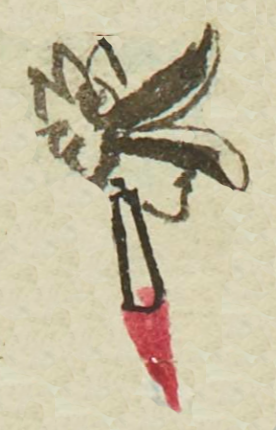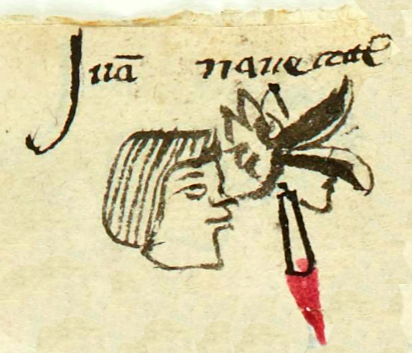Nauhecatl (MH604r)
This black-line drawing of the simplex glyph for the personal name Nauhecatl (or Nahui Ehecatl, "4-Wind," attested here as a man’s name) shows the glyph for Ecatl (air, breath) or Ehecatl (wind, or the divine force of wind). It is difficult to tell what is below the Ecatl or Ehecatl glyph, but it would likely have something to do with the number four (nahui). That said, it appears to be a tube that comes out of the bottom of the head of the figure, and it seems to shoot fire (something red, at least), so the number four does not come to mind.
Stephanie Wood
The number four combined with wind would be a calendrical name (4-Ehecatl) in the 260-day divinatory calendar, called the tonalpohualli in Nahuatl. Calendrics held an important role in Nahuas' religious views of the cosmos.
Even though the name is glossed without the reduplication, the intention would seem to be wind. So, ecatl may well mean wind along with breath and air. We are preserving the glosses that spell ehecatl as ecatl.
Ecatl and ehecatl visuals often include a head/face with a beak-like protrusion. The two parts of the beak-like protrusion may be tubes (or another device) through which wind was imagined to blow. Gabrielle Vail and Christine Hernández (Re-Creating Primordial Time, 2013, ) describe Ehecatl as the wind aspect of Quetzalcoatl, and they note that Ehecatl "wears a buccal (duck) mask through which to blow wind." That the "beak" may have been perceived as a blowing device is supported by the glyph for Pitztli (below).[See also: Ryanne Maxine Meyersohn, Comprehensive Study of the Origin of Humankind (2023).]
John Montgomery drew a group of wind glyphs (possibly mainly Mixtec), showing the variety of ways the blowing device might look. It is published in FAMSI, Inc.
The object below the head, with its red tip, is somewhat reminiscent of the tlacuilo sign that is a painting implement with red paint on its lower tip. See below for the tlacuilo sign from the Matrícula de Huexotzinco folio 778 verso. This may be just a coincidence.
Stephanie Wood
Juā nauecatl
Juan Nauhecatl
Stephanie Wood
1560
days, días, fechas, dates, calendars, calendarios, viento

nahui, four, https://nahuatl.wired-humanities.org/content/nahui
eca(tl), breath, air, https://nahuatl.wired-humanities.org/content/ecatl
eheca(tl), wind, https://nahuatl.wired-humanities.org/content/ehecatl
Matrícula de Huexotzinco, folio 604r, World Digital Library, https://www.loc.gov/resource/gdcwdl.wdl_15282/?sp=290st=image.
This manuscript is hosted by the Library of Congress and the World Digital Library; used here with the Creative Commons, “Attribution-NonCommercial-ShareAlike 3.0 License” (CC-BY-NC-SAq 3.0).








